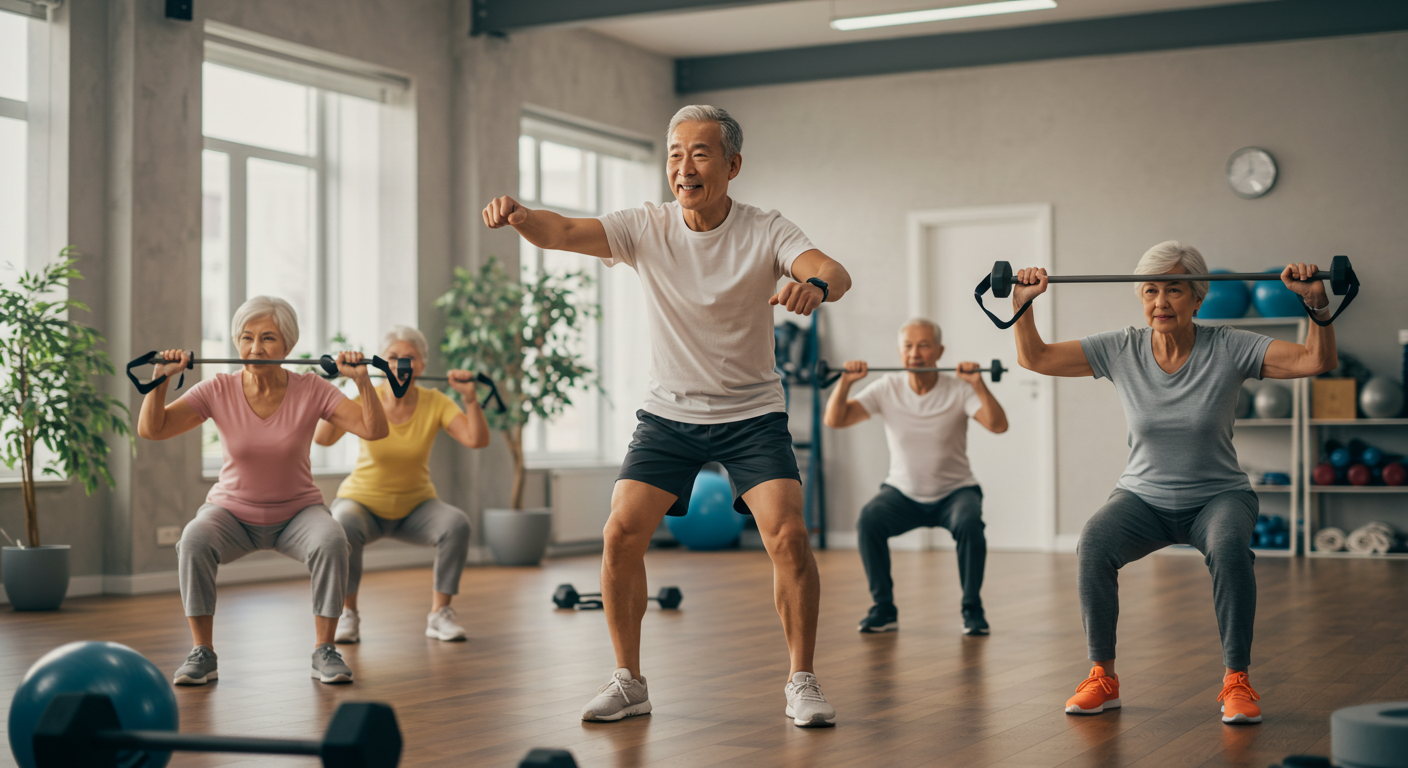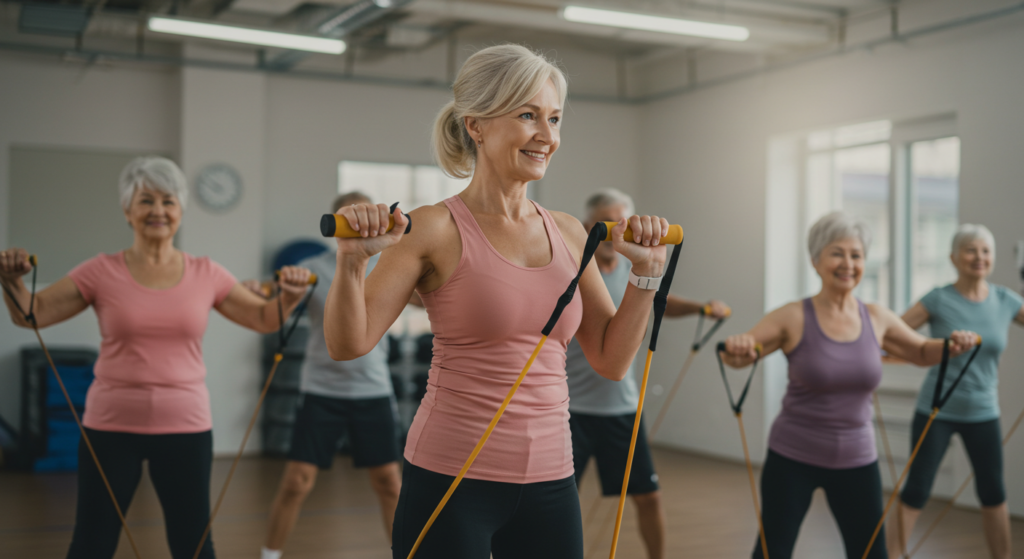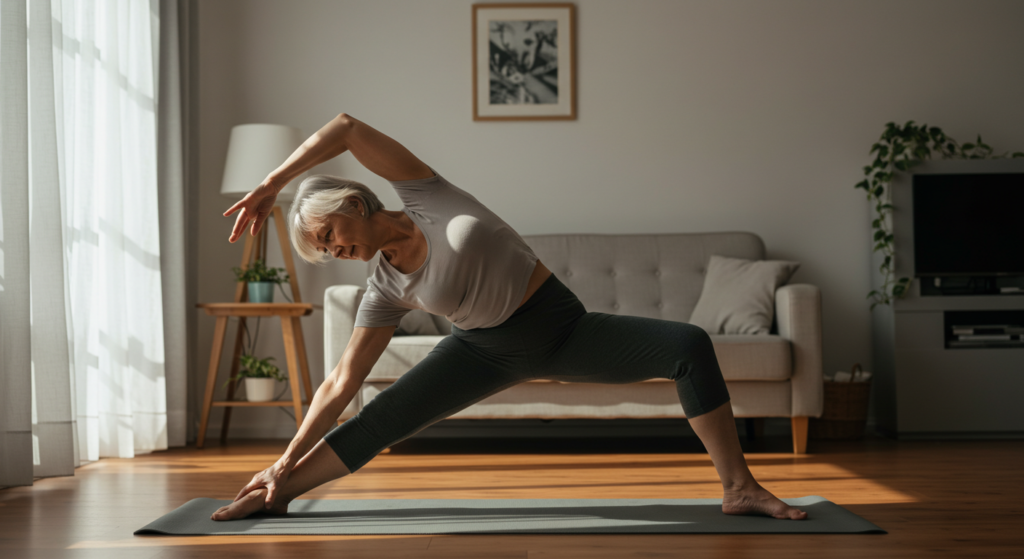
Discover how resistance exercise transforms health in old age. Learn benefits, safety tips, routines, and expert insights to stay strong, independent, and vibrant.

Introduction
Aging is a natural process, but how we age is within our control. Resistance exercise, often overlooked by seniors, is a powerhouse for maintaining strength, mobility, and overall well-being. With global life expectancy rising, prioritizing muscle and bone health is critical. In this guide, we’ll explore why resistance training is essential for older adults, debunk myths, and provide actionable steps to start safely.
Why Resistance Exercise Matters for Seniors
Resistance exercise (weight lifting, bands, bodyweight workouts) combats age-related decline. Here’s why it’s non-negotiable for healthy aging:
1. Preserves Muscle Mass & Strength
After 30, adults lose 3-5% of muscle mass per decade, accelerating after 60. Resistance training rebuilds muscle, improving functional strength for daily tasks like climbing stairs or carrying groceries.
2. Boosts Bone Density
Osteoporosis affects 1 in 3 women and 1 in 5 men over 50. Weight-bearing exercises stimulate bone growth, reducing fracture risks.
3. Enhances Metabolic Health
Muscle burns more calories than fat. Resistance exercise improves insulin sensitivity, lowering risks of diabetes and obesity.
4. Supports Joint & Heart Health
Strengthening muscles around joints reduces arthritis pain. Studies also link resistance training to lower blood pressure and improved cardiovascular function.
5. Sharpens Mental Health
Exercise releases endorphins, combating depression and anxiety. Resistance training also improves cognitive function, delaying dementia onset.

Types of Resistance Exercises for Seniors
Tailor your routine to your fitness level and goals:
1. Bodyweight Exercises
- Squats (assisted or chair-supported)
- Wall push-ups
- Step-ups
- Planks (modified on knees)
Benefits: No equipment needed, perfect for beginners.
2. Resistance Bands
- Band rows (for back strength)
- Leg presses
- Bicep curls
Benefits: Portable, low-cost, and gentle on joints.
3. Free Weights & Machines
- Dumbbell shoulder presses
- Leg extensions (using machines)
Benefits: Builds significant strength; ideal for gym-goers.
4. Water-Based Resistance
Aqua aerobics reduces joint strain while building endurance.
Safety Tips for Seniors Starting Resistance Training
- Consult a Healthcare Provider
Ensure exercises align with your health status, especially if managing chronic conditions. - Warm-Up & Cool Down
Spend 10 minutes on dynamic stretches (arm circles, leg swings) to prevent injury. - Focus on Form, Not Weight
Prioritize controlled movements over heavy lifting. Consider hiring a trainer initially. - Progress Gradually
Start with 1-2 sets of 8-12 reps, increasing weight or resistance by 5-10% weekly. - Rest & Recover
Allow 48 hours between sessions targeting the same muscle group.

Sample Weekly Resistance Training Plan
Day 1: Upper Body
- Wall push-ups: 2 sets of 10 reps
- Resistance band rows: 2 sets of 12 reps
- Dumbbell shoulder presses: 2 sets of 8 reps
Day 2: Lower Body
- Chair squats: 2 sets of 10 reps
- Step-ups: 2 sets of 12 reps (per leg)
- Resistance band leg presses: 2 sets of 15 reps
Day 3: Core & Balance
- Modified planks: 3 holds of 20 seconds
- Seated Russian twists: 2 sets of 15 reps
- Single-leg stands: 3 holds of 10 seconds (per leg)
Days 4-7: Light cardio (walking, swimming) or rest.
Debunking Myths About Resistance Exercise in Old Age
- Myth: “Lifting weights is dangerous for seniors.”
Truth: Properly supervised training is safer than a sedentary lifestyle. - Myth: “It’s too late to start.”
Truth: Studies show adults in their 80s and 90s can still gain muscle.
Overcoming Barriers to Exercise
- Time: Even 20-minute sessions twice weekly yield benefits.
- Cost: Use household items (water bottles as weights) or free online tutorials.
- Fear of Injury: Partner with a friend or join senior-specific classes.
FAQs
Q: How often should seniors do resistance exercises?
A: Aim for 2-3 sessions weekly, targeting all major muscle groups.
Q: Can resistance training help with arthritis?
A: Yes! Strengthening muscles around joints reduces pain and stiffness.
Q: What if I’ve never exercised before?
A: Start slow. Bodyweight exercises and bands are excellent entry points.
Conclusion
Resistance exercise is a game-changer for aging adults, offering a path to independence, vitality, and longevity. By integrating simple, safe routines into your lifestyle, you’ll not only add years to your life but life to your years.
Ready to take charge of your health? Share this guide with a loved one, and start your resistance training journey today!
Sources and References
1. Muscle Mass Loss & Resistance Training
- National Institute on Aging (NIA):
Discusses age-related muscle loss (sarcopenia) and the role of strength training.
https://www.nia.nih.gov/
Search terms: “sarcopenia,” “resistance exercise for seniors.” - Journal of Aging and Physical Activity:
Studies on muscle hypertrophy in older adults through resistance training.
Example study: Peterson, M. D., et al. (2010). “Resistance Exercise for the Aging Adult.”
2. Bone Density & Osteoporosis
- World Health Organization (WHO):
Global statistics on osteoporosis and recommendations for weight-bearing exercise.
https://www.who.int/
Search terms: “osteoporosis prevention,” “exercise for bone health.” - Mayo Clinic:
Guidelines on resistance training to improve bone density.
https://www.mayoclinic.org/
3. Metabolic & Cardiovascular Health
- American Diabetes Association (ADA):
Highlights resistance training’s role in improving insulin sensitivity.
https://www.diabetes.org/ - American Heart Association (AHA):
Links resistance exercise to improved heart health and blood pressure regulation.
https://www.heart.org/
4. Cognitive Benefits
- Alzheimer’s Association:
Research on exercise’s role in delaying cognitive decline.
https://www.alz.org/ - Harvard Medical School:
Study: “Exercise and Depression in Older Adults” (endorphin release and mental health).
https://www.health.harvard.edu/
5. Safety & Guidelines for Seniors
- Centers for Disease Control and Prevention (CDC):
Physical activity guidelines for older adults, including resistance training.
https://www.cdc.gov/ - National Strength and Conditioning Association (NSCA):
Evidence-based protocols for senior resistance training.
https://www.nsca.com/
6. Studies on Late-Life Muscle Gain
- Tufts University (Human Nutrition Research Center on Aging):
Research showing muscle growth in adults over 80 with resistance training.
Example study: Fiatarone, M. A., et al. (1994). “Exercise Training and Nutritional Supplementation for Physical Frailty in Very Elderly People.”









